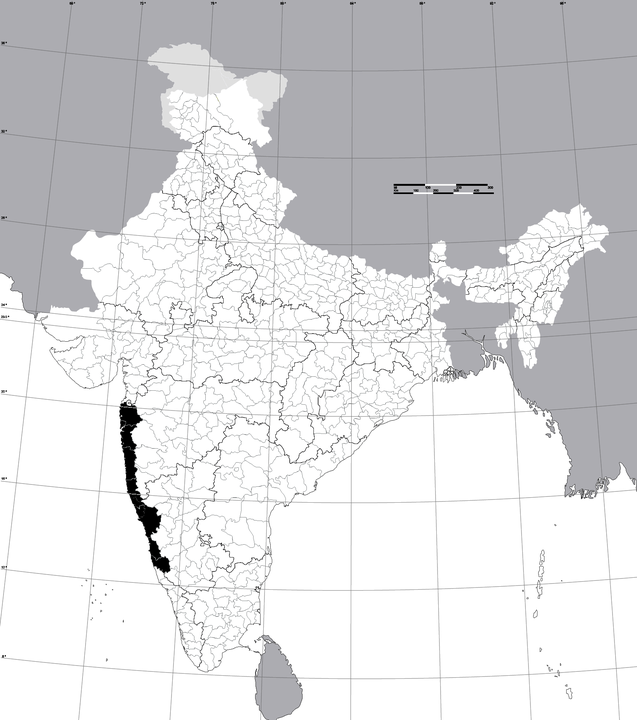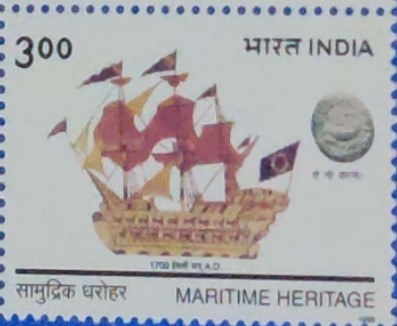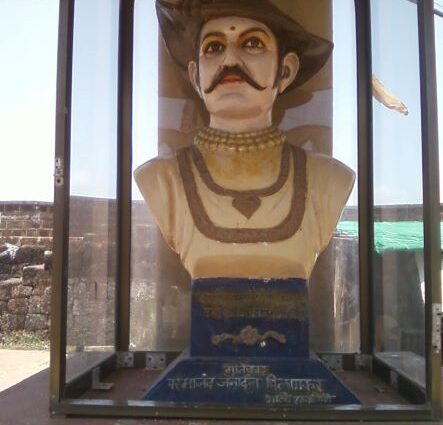Kanhoji Angre was a Hindu warrior who had no parallels in our history. Rising through the ranks, he became the most feared sea warrior on the Konkan coast in the early 18th century. All European naval powers, be they British, Portuguese or Dutch, could never defeat him. A few times, they combined their forces and even then failed to subjugate him. However, true to India’s secularism, he remains unsung, by and large.
The Marathas were said to be “the first and perhaps the only to employ a navy; indeed, as the saying still goes, Shivaji Maharaj carried the capital of his empire on the high seas. However, without Angre’s contribution, this capability could not have been achieved.
Since ancient times, Indian kings used the seas for trade and commerce; rarely have they looked to the sea for military or commercial conquest. Only the Cholas were the actual Hindu maritime empires as they conquered Srivijaya in Indonesia in the 11th century. Kanhoji’s name should be added to that illustrious list, right behind the Cholas, who secured India’s strategic Konkan coast.
Kanhoji was born in a normal Koli (fisherman) household, though his father served at Suvarnadurg under Shivaji with a command of 200 posts. He learnt the ropes of seafaring from his father. Initially, he had enemies all around him: British at Bombay, Portuguese at Goa, Siddis at Janjira and Dutch at Vengurla. Kanhoji started his career by attacking merchant ships of the East India Company and slowly gained respect from all the European powers. Soon his feats reached the ears of Maratha Emperor Sambhaji too, who granted him the command of the Survarnadurg fortress in 1688. Due to his sea exploits, he was made Sarkhel or Darya-Saranga (Admiral) by the Maratha chief in 1698. Slowly, he became a powerful master of the Western coast of India from Mumbai to Vingoria, barring Murud Janjira, which remained under Ethiopians.
Flushed with initial success, Angre made his capital at Vijayadurg near Malwan town, 485 km south of Mumbai, in 1698. Vijayadurg was known as the ‘Gibraltar of Asia’, a tribute to its invincible fortifications. The fort was originally built by king Bhoj and subsequently strengthened by Maratha ruler Chatrapati Shivaji Maharaj and was situated right on the coast and had an opening hollowed out to allow a ship to enter from the sea. After a few years, as his territory increased exponentially, Angre created another operating base at Alibaug, near Mumbai. From here, he levied a tax on every merchant vessel entering the harbour. He even issued his own currency as a silver coin, the Alibagi rupaiya.
As his power increased, he kept on increasing the count of his forts and ports. In 1724, Angre built another port at Purnagad, Ratnagiri. At one time, Kanhoji was so successful that he attracted enterprising Europeans into his fleet as mercenaries. He also had a keen eye for talent and went on recruiting skilled European soldiers. He preferred Dutch mariners to command his best vessels, mainly because Dutch was the dominant power on the Western coast at that time. They remained powerful till Travancore king Marthand Varma defeated and expelled them from India in 1741. He also employed a Jamaican pirate named James Plantain, who was appointed chief gunner. Angre employed Manuel de Castro, a Portuguese soldier who was about to be punished by the East India Company for failing to capture Khanderi Island, which Angre controlled. At the height of his power, Kanhoji commanded thousands of sailors.

In 1702, he abducted a merchant vessel from Calicut with six English sailors and took it to his harbour. In 1707, he attacked the ship East Indiaman Bombay which blew up during the fight. On 4th November 1712, his navy captured the yacht HCS Algerine of the President of Bombay, William Aislabie, killing the chief of their Karwar factory, Thomas Chown, and making his wife a prisoner. Both yacht and Mrs. Chown were released only after the payment of 30,000 Rupees. The East India Company President Aislabie was forced to sign a treaty with him to stop harassing the Company’s fleet. Angre compelled the foreign traders to buy a license, called dastak, from him to enter the Indian waters. Any failure on their part was met with swift reprisal, by way of the capture of men, women and the destruction of their ships.
Charles Boone, the new British Governor of Bombay, made several attempts to capture Angre in 1715 but failed miserably. Angre responded by capturing three East India Company merchant ships in 1718. In 1721, the Portuguese and British decided to pool their resources to fight Angre but, even then, could not succeed. Kanhoji beat them in both war and diplomacy. Not only did he defend his forts, but he also managed to get the Maratha army under Pilaji Jadhav to come to his rescue. He never forgot to keep Marathas in good humour, and in turn, they also helped him whenever required. The synergy kept various invaders at bay. Angre would go on to become sarkhel in his own right and defeat every invader at sea, never losing a battle — a remarkable feat considering how his smaller ships were outstripped by the blue water navies of the Western powers.
At that time, the Europeans thought he could capture any merchant ship except large, heavily armed ships. The reason behind his victories was his tactful leadership. His strategy involved deliberate manoeuvres that set the odds in his favour, as well as avoiding waging too many fights simultaneously. Despite the Company’s superior weaponry, Angria was able to capitalise on his comparative advantage by employing small, readily negotiated, quick-sailing boats and powerful defensive fortifications. Even at his peak in 1729, Angre had mere 80 ships, many of them nothing more than retrofitted fishing boats engineered by the local kolis. Nonetheless, Angre built a frightening power in the name of the Maratha Emperors over a broad expanse of the west coast with that little fleet and an unrivalled strategic genius. Moreover, Kanhoji Angre even established a naval base on the Andaman and Nicobar Islands. Due to his efforts only, the Islands are now part of India.
He knew his coast and the advantages of fighting near the coast. He made sure to fight his battles in his strong turf of shallow waters, never venturing into the deep sea. Unlike other Hindu warriors, he knew his strengths and weaknesses well. This factor propelled him into a league of Shivaji, Lachit Barphukon and Nayaki Devi, who fought on their own chosen terrain. Surprise and stealth were his preferred methods at sea, as they were on land. He drew much-larger enemy ships into the shallows, where they would collide with the rocks, then hammered them with cannon fire before boarding for close combat.
When the British could not defeat him in the battle, they resorted to dirty psychological warfare. To drive the wedge between Angre and Maratha Peshwas, they spread the rumour that he was of Ethiopian descent. However, even this tactic failed as he took full advantage of such misconception and played it up to build his aura of invincibility. The British then branded him as nothing more than a pirate, a derogatory term for any self-respecting warrior, ignoring that no less than the Maratha king had appointed him. However, this strategy also failed to make a dent at that time. Later, Nehruvian secularism picked this theory which spoiled generations of scholarship on Konkan history. He was relegated to a mere footnote in Indian history. On top of that, to Angre’s misfortune, Shivaji’s success and fame far overshadowed his exploits at sea.
After his death on 4 July 1729, his son ascended the throne but could not continue his father’s feats. He could not get along with Peshwas and both started fighting each other. Taking advantage of the internecine warfare, the British wiped out the glorious Angre kingdom marking the end of Maratha’s naval supremacy. Kanhoji Angre is one of the most notable admirals of the Maratha Navy who caused significant troubles for European trading companies. Kanhoji is credited with foreseeing that the ultimate and strategic function of a Blue Water Navy is to keep the enemy engaged far from the coasts of the motherland. On the contrary, since ancient times, other Hindu kings remained mired in Maginot Mentality, a defensive barrier or strategy that inspires a false sense of security. The situation, in this regard, has not changed a bit, even now.
The Indian public does not know much about brave Hindu warriors, and Angre is no exception. However, the Indian Navy does recognise his achievements. Today, a statue of Angre stands in the Indian Naval Dockyard in Mumbai. While the original fort built by Angre that overlooked the Naval Docks has vanished, its boundary wall is still intact. Within it lies the Headquarters of Indian Western Naval Command, INS Angre. Angria Bank, a submerged atoll located some 105 km west of Vijayadurg, was named after Kanhoji Angre.
The Indian Postal Service also issued a Rupee 3 stamp in April 1999 depicting a ghurab of Kanhoji Angre’s fleet as shown in a 1700 CE artwork. The old Kennery Lighthouse on Khanderi Island, near Mumbai, was renamed Kanhoji Angre Light House. Angre Port, an all-weather port in Ratnagiri, Maharashtra, was launched in 2012 by Kanhoji Angre’s 9th descendant. The character Sri Sumbahjee in the Hollywood film, ‘Pirates of the Caribbean: At World’s End’ was a clear homage to Sambhaji, Kanhoji Angre’s son.

His might was such that even when he was fighting his enemies, his vassals continued buying the dastaks issued by him. An English writer, Grose, praised him stating that even though Kanhoji was ‘very severe in his commands, and exact in punishing’, yet ‘he was liberal to his officers and soldiers with whom he affected a sort of military frankness’ and as a true Maratha, he was ‘very careful of keeping faith’. Historian Jadhunath Sarkar correctly pointed out that his genius lay in founding the Maratha navy and naval bases to fight the Western powers at sea and prevent them from occupying the West coast.
Kanhoji remained undefeated, unrivalled and unmatched throughout his life and was instrumental in delaying the British dominance in the Bombay region by at least 50 years. In that sense, he was the first champion of Hindu resistance to European Imperialism.
Written by Amit Agarwal, author of the bestsellers on Indian history titled “Swift horses Sharp Swords” and a “Never Ending Conflict”.
Follow on Twitter @amit1119 and Instagram/ Facebook at amitagarwalauthor.
You may buy his books at Amazon and flipkart:
https://garudabooks.com/a-never-ending-conflict-episodes-from-indic-resistance
https://www.amazon.in/dp/B0B6J5PKPR
https://www.flipkart.com/swift-horses-sharp-swords hindi/p/itma73556f905812?pid=9789355788269 (Hindi)
![]()
- How Hindu rituals spawned numerous advancements in science, maths and other arts - March 13, 2024
- Naga Sadhus and their fighting skills - February 20, 2024
- Lessons for India from the Israel-Palestine conflict - October 12, 2023

